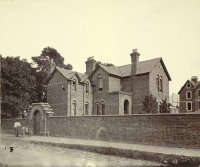Introduction: The 19th century witnessed a remarkable transformation in British architecture, characterized by a diverse range of styles and an unparalleled surge of innovation. This period marked a shift from the neoclassical designs of the previous century to a more eclectic and experimental approach. From the grandeur of Gothic Revival to the simplicity of Georgian architecture, this essay explores the fascinating tapestry of British architecture in the 1800s.
Neoclassicism and Georgian Architecture: At the turn of the 19th century, neoclassicism still prevailed as a dominant style, reflecting the ideals of the Enlightenment era. The Georgian architecture, with its symmetrical facades, proportioned designs, and elegant embellishments, continued to influence the architectural landscape of Britain. The works of renowned architects such as Robert Adam and John Nash stand as testaments to the enduring elegance and grace of Georgian architecture.
Gothic Revival: As the 19th century progressed, a revival of medieval Gothic architecture gained popularity. Spearheaded by influential figures like Augustus Pugin, the Gothic Revival movement sought to revive the grandeur and craftsmanship of the medieval past. This style emphasized pointed arches, intricate tracery, and elaborate ornamentation, as exemplified by the iconic Houses of Parliament, designed by Charles Barry and Pugin.
Victorian Architecture: The Victorian era witnessed a flourishing of architectural innovation, fueled by technological advancements and changing societal needs. The Industrial Revolution led to the mass production of building materials such as iron, steel, and glass, allowing for daring structural experiments and larger, more open interiors. The advent of the railway also facilitated the expansion of cities, leading to the construction of grand train stations like St Pancras in London, designed by Sir George Gilbert Scott.
The Arts and Crafts Movement: Towards the end of the 19th century, a reaction against mass production and industrialization gave rise to the Arts and Crafts movement. Advocated by figures like William Morris, this movement emphasized the revival of traditional craftsmanship and the integration of art into everyday life. Buildings of this period showcased a return to simplicity, with a focus on natural materials, handcrafted details, and a harmonious relationship with the surrounding environment.
High Victorian Gothic: In the latter half of the 19th century, a distinct variant of Gothic Revival, known as High Victorian Gothic, gained prominence. This style, characterized by intricate detailing, soaring spires, and a rich palette of colors, reflected the confidence and opulence of the Victorian era. Exemplary works of High Victorian Gothic include the iconic Midland Grand Hotel at St Pancras, designed by George Gilbert Scott.
Conclusion: The architectural landscape of 19th-century Britain encapsulates a remarkable era of diversity, innovation, and artistic expression. From the refined elegance of Georgian architecture to the grandeur of Gothic Revival and the daring experiments of the Victorian era, each style played a significant role in shaping the built environment of the time. These architectural achievements not only reflected the changing aesthetics and societal aspirations but also demonstrated the remarkable skill, craftsmanship, and ingenuity of British architects. The legacy of British architecture in the 1800s continues to captivate and inspire, reminding us of the enduring power of architecture to shape and define our world.
